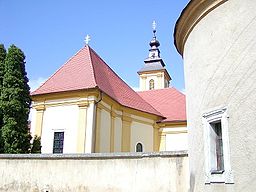Pobedim
| Pobedim | |
| Village | |
|
Saint Michael's church, Pobedim
|
|
| Country | Slovakia |
|---|---|
| Region | Trenčín |
| District | Nové Mesto nad Váhom |
| Elevation | 169 m (554 ft) |
| Coordinates | 48°39′N 17°48′E / 48.650°N 17.800°ECoordinates: 48°39′N 17°48′E / 48.650°N 17.800°E |
| Area | 8.609 km2 (3.324 sq mi) |
| Population | 1,218 (2004-12-31) |
| Density | 141/km2 (365/sq mi) |
| First mentioned | 1355 |
| Postal code | 916 23 |
| Area code | +421-32 |
| Car plate | NM |
| Statistics: MOŠ/MIS | |
| Website: at e-obce.sk | |
Pobedim (Hungarian: Pobedény) is a village and municipality in Nové Mesto nad Váhom District in the Trenčín Region of western Slovakia. A Slavic hill fort from the pre-Great Moravian period has been uncovered in the locality Hradištia. The hill fort belongs to Early Medieval sites with the highest number of artifacts found in Slovakia.
The municipality lies at an altitude of 169 metres and covers an area of 8.609 km². It has a population of about 1,218 people.
The village was first mentioned in 1392, but the area was occasionally inhabited from the Late Stone Age. The settlement is documented also from the Early Bronze Age and especially in the Late Bronze Age. The people of Lusatian culture built their settlement in the local swamps and left numerous artifacts (cultic artifacts, metallurgical tools, fragments of bronze, ceramics, etc). The area was then settled by the Celts. In the Roman period, it was more or less uninhabited and only one finding is known from the Migration period.
The locality had been intensively colonized by the Slavs at the end of the 5th and in the 6th century (localities Horné Pole and Dolné Pole). The Slavic hill fort was built at the end of the 8th century and was destroyed for the first time at the end of the first third the 9th century. The destruction of the hill fort is usually associated with the unification of the Principality of Nitra and the Principality of Moravia (the attack of Mojmír's army or Pribina's attack preceding his expulsion, depending on principality to which is Pobedim attributed; neither destruction during other internal conflict related to integration processes of the Slavs cannot be excluded). Radiocarbon dating indces that construction activities were realized also in the turnover of the 9th/10th century.
...
Wikipedia



